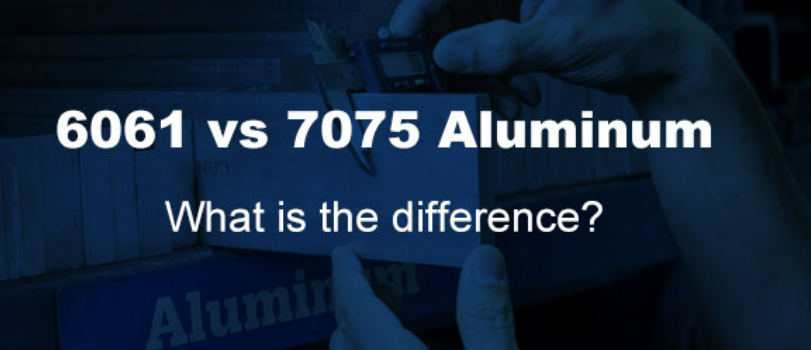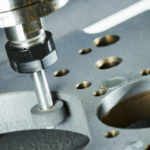In the recent use of aluminum alloys, the two most commonly used grades are the 6061 aluminum and the 7075 aluminum. Many aluminum alloy users have found it difficult to differentiate these two alloys for usage within the industry. However, both alloys bear their distinct properties that differentiate each from one another.
As a result, it is important to understand the differences between these two alloys. This allows for an effective selection of materials of the best fit for a project. This post shows the obvious differences between 6061 Aluminum and 7075 Aluminum.
Basic Introduction To 6061 And 7075 Aluminum
As we have mentioned earlier, the objective of this article is to throw more light on the difference between 6061 aluminum and 7075 aluminum. Before we go deep into the review guide, let’s examined each grade of aluminum.
6061 Aluminum Grade
Aluminum 6061 is one of the most versatile heat-treatable alloys of aluminum. This aluminum grade which is originally called “Alloy 61S” was developed in 1935. This alloy is one of the most commonly used aluminum grades. This is because it exhibits a wide range of mechanical properties as well as corrosion resistance. The 6061 Aluminum can be easily fabricated, exhibit excellent formability, and weldable using all methods with furnace brazing inclusive. This grade of aluminum alloys comes from the aluminum series 6xxx.
The Aluminum 6061 is made up 95.8 to 98.6% aluminum, with 0.8 to 1.2% magnesium, and 0.4 to 0.8% Silicon. Besides, it contains a trace number of elements including Copper, Chromium, and more.
7075 Aluminum Grade
The alloy – 7075 aluminum was first developed secretly by a Japanese company in 1936. It was later introduced by Alcoa in 1943. The 7075 aluminum exists to be one of the highest strength alloys of aluminum with an excellent strength-to-weight ratio. It offers a wide range of impressive mechanical properties and features good resistance to fatigue and good ductility. As a result of its excellent properties, it is extensively used for highly stressed applications and in aircraft structural parts.
7075 aluminum alloy contains 5.6 to 6.1% zinc, 2.1 to 2.5% magnesium, and 1.2 to 1.6% copper. Other metals in its compositions include silicon, manganese, chromium, titanium, iron, and more. In addition, the aluminum 7075 alloy comes from the aluminum alloy series 7xxx.
Now that we have an understanding of what 6061 aluminum and 7071 aluminum are, then we can proceed to access the differences between the two alloys.
What Differentiates Between Aluminum 6061 and Aluminum 7075?
The 6061 Aluminum and the 7075 Aluminum exhibit excellent properties which are common to both while some properties differentiate the two from one another. The key differences are the type of alloys series, chemical components, mechanical properties, and applications.
For easy understanding, we will expatiate on each attribute to draw a comparison between 6061 and 7075 aluminum alloy grades. The essence of doing this is to give manufacturers more insight before setting upon a particular alloy. The following attributes for the comparisons:
- Alloy Series
- Chemical Component
- Mechanical Properties (for example, Yield Strength, Elasticity, Thermal Conductivity, Electrical Resistivity, Material Hardness, and Machinability)
- Applications
- Fabrication Consideration
6061 vs 7075 Aluminum: Alloy Series
The 6061 aluminum grades exist in pre-tempered and tempered grade. This include:
- The 6061-O: Annealed (bendable condition or “soft”,)
- Heat Treated 6061-T4 (naturally aged)
- Heat Treated 6061-T6 (artificially aged)
- Heat Treated 6061-T65 (artificially aged)
- Heat Treated 6061-T6511 (artificially aged)
The 7075 Aluminum grade is produced in a wide range of tempers. This include:
- 7075-O
- 7075-T6
- 7075-T651
6061 vs 7075 Aluminum: Chemical Components
While the composition of the alloy of 6061 aluminum and 7075 aluminum are similar, the actual composition of the component of each grade differs significantly.
The table below shows a summary of the alloy composition of 6061 aluminum and 7075 aluminum.
Table Summary
| Element | 6061 Aluminum | 7075 Aluminum |
| Aluminum | 95.85 – 97.90 % | 86.90 – 91.40 % |
| Silicon | 0.40 – 0.80 % | 0.00 – 0.40 % |
| Zinc | 0.00 – 0.25 % | 5.6 – 6.10 % |
| Magnesium | 0.80 – 1.20 % | 2.1 – 2.50 % |
| Manganese (Mn) | 0.00 – 0.15 % | 0.00 – 0.30 % |
| Chromium | 0.04 – 0.35 % | 0.07 – 0.23 % |
| Copper | 0.15 – 0.40 % | 1.20 – 1.60 % |
| Iron (Fe) | 0.00 – 0.70 % | 0.00 – 0.50 % |
| Titanium (Ti) | 0.00 – 0.15 % | 0.00 – 0.2 % |
| Zirconium | – | 0.00 – 0.25 % |
| Residuals | 0.00 – 0.15 % | 0.00 – 0.15 % |
6061 vs 7075 Aluminum: Mechanical Properties
For mechanical property comparison, various factors are used to differentiate the 6061 aluminum from the 7075 aluminum. These factors include:
- Yield Strength
- Elasticity
- Thermal Conductivity
- Electrical Resistivity
- Material Hardness
- Machinability
Yield Strength Comparison
The yield strength of a material is said to be the maximum stress at which a material begins to deform permanently. In comparison, 7075 aluminum possesses a higher yield strength than 6061 aluminum. In essence, 7075 aluminum can withstand more at higher impact and pressure without deformity for some time. This property is a result of heat treatment as well as the chemical composition of 7075 aluminum. On the other hand, 6061 aluminum is not entirely weak but possesses slightly lower yield strength compared to 7071 aluminum.
Elasticity Comparison
In this context, elasticity is the ability of a material to return to its original shape after the deformation force is removed. However, when we compared Young’s tensile modulus of both alloys, it shows that they respond almost equally. In terms of metric 6061 aluminum has 69 GPa while 7075 aluminum possesses 70 GPa.
Thermal Conductivity
Thermal conductivity Is a metric used to quantify the ability of a material to transfer or conduct heat. Generally, aluminum alloys are not used for insulation. This is because all forms of aluminum alloys are good conductors of heat. The chemical composition of both heat-treated grades of aluminum alloys contributes significantly to their thermal conductivity.
In this case, 6061 aluminum possesses slightly higher thermal conductivity in comparison with 7075 aluminum. Consequently, 6061 aluminum is preferred when heat dissipation is primarily required, for example, heat exchangers.
Electrical Resistivity
The electrical resistivity of a material is a measure of the resistance to the transfer of electricity. When we examined the two alloys closely, both possess low electrical resistivity. However, 6061 aluminum display the lowest electrical resistivity which means that it is a good conductor in comparison with 7075 aluminum.
Material Hardness Comparison
Material hardness involves the ability of a material to resist deformation either by penetration or indentation. Hard materials are mostly brittle and they dent easily while less hard materials are ductile and can withstand bending without denting under pressure. Comparing the two alloys both are hard enough to resist deformity without cracking under pressure. However, our hardness test reveals that 7075 aluminum is harder in comparison with 6061 aluminum.
Machinability Comparison
The machinability of material is referred to as the ease with which a material can be cut (machined) to obtain an acceptable surface finish. These machining activities may include milling, cutting, die-casting, and more. Another way to look at machinability is for fabrication consideration. To understand this, we have to look at the criteria for fabrication. 6061 aluminum is said to have low tensile stress and low hardness compared to 7075 aluminum. Consequently, 6061 can be machined easily than its counterpart – 7075 aluminum.
| Properties | 6061 Aluminum | 7075 Aluminum | ||
| Units | English | Metric | English | Metric |
| Yield Strength | 40,000 psi | 276 MPa | 503 MPa | 73,000 psi |
| Melting Point | 1080 to 1205oF | 582 to 652oC | 477 to 635oF | 477 to 635oC |
| Thermal conductivity | 1160 BTU-in/hr- ft²-°F | 167 W/m-K | 900 BTU-in/hr- ft²-°F | 130 W/m-K |
| Elasticity Modulus | 10,000 ksi | 68.9GPa | 10,400 ksi | 68.9 Gpa |
| Electrical Resistivity | 3.99 x 10-6 ohm-cm | 5.15 x 10-6 ohm-cm | ||
| Machinability | Good | Fair | ||
| Hardness (Brinell) | 95 | 150 | ||
6061 vs 7075 Aluminum: Common Applications
6060 Aluminum Applications
The 6061-aluminum grade is called a structural aluminum alloy due to its workability. It can be rounded, rolled, extruded, squared, or formed into a plate or any form. In the world today, 6061 aluminum is found in large quantities in a wide range of applications. These industries include:
- Automotive industries
- Modern aircraft industries
- Building construction industry e.g. subway platforms, stairs, flooring, cover plates, walk away, and more.
- Consumer products e.g. bicycle frames and components, small utility boats, fishing reel, SCUBA tanks., docks gangways, and more
- Electrical fittings.
- Food industries especially for canned foods
As listed above, the 6061 aluminum is used to provide superb strength in today’s car for fuel efficiency and cost-saving. While it weighs about one-third as much as steel, it helps to increase strength with fuel economy and increased performance inclusive.
Due to the excellent machinability of 6061 aluminum, it is used in the aircraft industry for welding and joining different components of the aircraft. However, welding may reduce the strength of 6061 aluminum, but the strength can be resolve by heat treatment upon finishing the welding process.
6061 is highly resistant to corrosion – no wonder for its choice in the marine industry. In this case, additional powder coating or painting is required. This will help to provide complete protection against unforeseen forces of nature. With an effective coating, seawater will not have a corrosive effect on 6061 aluminum. Also, this alloy is used for fishing equipment, boat hulls, scuba diving equipment, docks, marine firearms, mooring, and many more.
7075 Aluminum Applications
In application, 7075 aluminum is used as a replacement for steel when lightweight and strength is required at the same time. This is due to its superior strength to weight ratio compared to 6061 aluminum. 7075 Aluminum came as a result of a bid to solve arising questions on weight and strength in the aviation industry.
7075 Aluminum contains zinc as its primary alloy, as a result, it performs exceptionally well in highly stressed environments. It can also be found in an innumerable number of products today including the following:
- Industrial tooling and molding
- Aviation industry e.g. aircraft
- Transportation industries
- Rock climbing and inline skate equipment
- Firearms
- Camping utensils
6061 Vs 7075 Aluminum: Fabrication Considerations
In comparison, fabrication ability can help to differentiate 6061 aluminum form 7075. The 6061 aluminum boasts of better fabrication compared with 7075 aluminum. This is attributed to the lower hardness and tensile stress of 6061 aluminum. In conclusion, 6061 aluminum possesses better formability than the 7075 aluminum.
Other Properties
6061 vs 7075 Aluminum: Corrosion Resistance Comparison
When we compare the resistance of 6061 and 7075, we discovered that the aluminum alloy grade 6061 has more resistance to corrosion than 7075. This is a result of the chemical composition of both alloys. The copper component in 7075 alloy is higher compare to 6061. This composition gives the 7075 aluminum the ability to react with the environment for corrosion to occur.
6061 vs 7075 Aluminum: Weldability Comparison
As said earlier, 6061 aluminum has an edge over 7075 aluminum when it comes to fabrication. This is due to its lower hardness and tensile stress. In addition to this, both alloys can be joined by a different method including soldering, brazing, or adhesive. However, 6061 aluminum is considered to be weldable while 7071 aluminum is considered not weldable.
While 6061 aluminum is said to be weldable, proper care must be taken in the selection of the perfect weld filler metal. To get the weld back to the original “T” designation, post-weld heat treatment and aging may be required. As for 7075 aluminum, it is extremely susceptible to cracking after welding.
6061 vs 7075 Aluminum: Melting Point
Melting point refers to the temperature with which a material will phase-change from solid to liquid. This is reported as a range due to the variance of temper’s unique phase state, and the chemical composition of the materials. It is quite interesting that, despite the hardness of 7075 aluminum which is twice as strong as 6061 aluminum, it melts at a slightly lower temperature. This discovery is important for the heat treatment process. This is because the right temperature must be achieved to distribute the alloying elements equally into the base metal.
6061 vs 7075 Aluminum: Weight Comparison
In comparison as regards weight, 7075 aluminum has a higher strength to weight ratios than the 6061 aluminum. This is why the 7075 aluminum is preferred over 6061 aluminum as they can create lightweight frames for superior handling and greater fight range. For the strength to weight ratio, the 6061 aluminum is rated 115KN-m/Kg while the 7075 aluminum is rated 196 KN-m/Kg
6061 vs 7075: Price Comparison
When we compare the price of 6061 aluminum and 7075 aluminum, it clear that 7075 aluminum is more expensive. As a result, it is mostly used when its improved strength becomes a necessity. While it has a wide range of applications, it is mostly used in the aircraft industries. However, if your project requires 7075 aluminum properties, then it should be considered to obtain the desired result.
How To Tell The Difference Between Aluminum 6061 And Aluminum 7075
To be able to tell a difference between aluminum grade 6061 and aluminum grade 7075 is very important. This is because it is required for the selection of materials for projects. If the wrong materials are selected, then it will affect either during the project or in the future. This may be in terms of properties like corrosion, strength, machinability, elasticity, electrical conductivity, and many more. Our guide has been able to educate more on the properties to differentiate both alloys from one another.
There are several ways to tell a difference between 6061 aluminum and 7075 aluminum. Here we will discuss two ways to tell a difference.
- The use of HCL
Get a small piece of 6061 aluminum and 7075 aluminum. Pour a few drops of the solution on the metal craps. Leave the metal craps for a few minutes for reactions to occur. After a few minutes, the two alloys will react differently to the solution.
After a few minutes, if the metal turns black, it is said to be 7075 aluminum. This is because of the high composition of Zinc which reacts with the solution. However, if the metal crap shows no reaction or very minimal reaction with no black coloration, then it is 6061 aluminum. This is because it contains little or no zinc in its composition.
- Test for hardness
To test the difference between the two alloys, we used Aluminum 6061 and Aluminum 7075 of equal dimension for the experiment. First of all, we hit the two-metal craps of equal dimension with the same force repeatedly.
It was shown that after applying the same impact on the two plates, the 6061-aluminum plate was mostly bent compared to the 7075 aluminum. This shows that 6061 became deformed more than the 7075 aluminum. This can be attributed to the hardness of both alloys. 6061 is less hard compared to 7075. Furthermore, we continue to try to completely break the two alloys using the same impact. We discovered that aluminum 7075 broke one or two impacts earlier than aluminum 6061.
F.A.Q
Summary: 6061 VS 7075 Aluminum, Which One Is Better?
We know that the question running through your mind is “which alloy is better for my project?”. This question is quite ambiguous. This means that it has no specific answer. Knowing which aluminum alloy is best for your application requires quite a lot of expertise, trial, and error. It all depends on the requirement of your projects.



